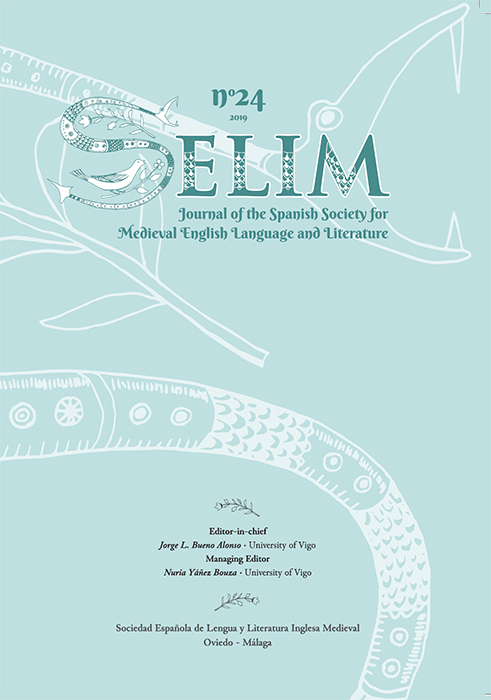Abstract
The aim of this article is to determine if the Old English verbs bewerian, forbēodan, foresacan, forwiernan, stīeran and tōcweþān constitute a unified class of prohibition. The theoretical model is provided by the framework of verb classes and alternations, as well as by Role and Reference Grammar. Class membership requires not only similar meaning components but also shared grammatical behaviour. While bewerian, forbēodan and forwyrnan are found in three syntactic configurations, and in the Nominalisation and Undergoer alternations, foresacan, stīeran and tōcweþān occur in one syntactic configuration only and do not take part in these alternations. The main conclusion of this article is that these verbs do not show a similar grammatical behaviour and, therefore, cannot be said to represent a consistent verbal class.
Keywords: Old English; verb classes; alternations; Role and Reference Grammar
References
Bosworth, J. & T. N. Toller 1973 [1898]: An Anglo-Saxon Dictionary. Oxford, Oxford University Press.
Cortés Rodríguez, F. & M. González Orta 2006: Anglo-Saxon Verbs of Sound: Semantic Architecture, Lexical Representation and Constructions. Studia Anglica Poznaniensia 42: 249−284.
Cortés Rodríguez, F. & M. A. Martín Díaz 2003: The Meaning-Syntax Interface of Writing Verbs: Templates, Constructions and Linking Rules within a Lexical Grammar of Old English Verbal Predicates. Revista Canaria de Estudios Ingleses 47: 13−35.
Foley, W. & R. Van Valin 1984: Functional Syntax and Universal Grammar. Cambridge, Cambridge University Press.
García Pacheco, C. L. 2013: Los Verbos de Sentimiento en Inglés Antiguo: Arquitectura Léxica e Interfaz Semántica-Gramática. (Ph.D. dissertation.) Universidad de La Laguna.
García Pacheco, L. M. 2013: El Dominio Verbal de la Existencia en Anglosajón. Análisis Semántico-Sintáctico. (Ph.D. dissertation.) Universidad de La Laguna.
González Orta, M. 2002: Linking Syntax and Semantics in Old English Verbs of Warning. Estudios Ingleses de la Universidad Complutense 10: 157−182.
González Orta, M. 2003: The Old English Verbs of Smell Perception and Emission: Analysis of the Interface of their Semantic and Syntactic Representation. SELIM 12: 33−48.
González Orta, M. 2004: Diccionario Sintáctico del Léxico Verbal del Inglés Antiguo: Verbos de Habla. Servicio de Publicaciones, Universidad de La Laguna.
González Orta, M. 2005: The Interrelation of Semantic Structure and Syntactic Variation in Old English Verb Classes: Catalogue of Syntactico-Semantic Constructions. Revista Alicantina de Estudios Ingleses 18: 111−128.
González Orta, M. 2006: The Resultative Construction in Old English: Towards a Semantic Network of Verb Classes. Studia Neophilologica 78: 123−137.
diPaolo Healey, A. ed. 2016: The Dictionary of Old English in Electronic Form A−H. Toronto: Dictionary of Old English Project, University of Toronto.
diPaolo Healey, A. ed. with J. Price Wilkin & X. Xiang 2004: The Dictionary of Old English Web Corpus. Toronto, Dictionary of Old English Project, University of Toronto.
Levin, B. 1993: English Verb Classes and Alternations. Chicago, University of Chicago Press.
Roberts, J. & C. Kay with L. Grundy 2000 [1995]: A Thesaurus of Old English. 2 vols. Amsterdam, Rodopi.
Van Valin, R. 2005: Exploring the Syntax-Semantics Interface. Cambridge, Cambridge University Press.
Van Valin, R. 2014: Some Questions Concerning Accomplishments. Lecture delivered at the 2014 Symposium on Verbs, Clauses and Constructions, held at the University of La Rioja.
Van Valin, R. & R. LaPolla 1997: Syntax: Structure, Meaning and Function. Cambridge, Cambridge University Press.




